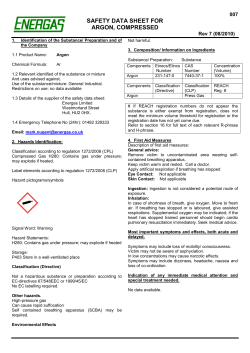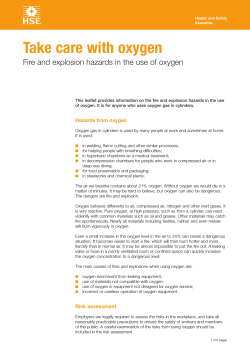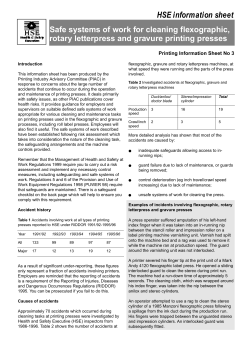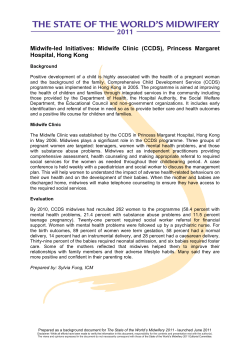
Document 124538
Safety Guideline for Users : Medical Oxygen Systems at Home and At Public Places Coordinating Committee in Hospital Authority 16 In Occupational Therapy Content In The Event of Incident or Emergency Introduction p.3 General Considerations p.4 Using Oxygen Therapy at Home p.6 General Safety Considerations Regarding Stationary Systems p.6 General Consideration in Handling Portable Oxygen Systems p.8 Travelling with Portable Oxygen Systems p.10 General Safety Considerations When Travelling with Oxygen p.11 In The Event of Incident or Emergency p.15 2 1. Evacuate the area when there is a fire. 2. Stop the vehicles and switch off the engines. 3. Get out of the public places or vehicles immediately or as instructed by helpers on site. 4. Remove the ambulatory oxygen from the site if safe to do so. 5. Notify the emergency services and inform them of the presence of ambulatory oxygen on site if not removed. 15 Introduction 13. Since the release of oxygen from cylinder could accelerate fire, it should kept be Introduction away from sources of heat and potential sparks. p.3 14. In no circumstance that smoking or open flames should be permitted in passenger compartment when medical oxygen is present. 15. Consider to use shorter length of oxygen tubing with portable oxygen devices for outdoor activities and keep the cylinders close to the users when they are in use. 16. Do not leave the portable oxygen systems unattended when the valves of the cylinders are opened. Medical oxygen is an essential requirement for some people who have respiratory diseases. In Hong Kong, home oxygen therapy for needed persons is primarily a medical prescription and has been handled under professional standards. Although home oxygen therapy is increasingly widespread, the knowledge about it is not. Proper and safe use of home oxygen therapy is imperative to enhance its effectiveness thus, in effect, improving quality of life for the users. On the contrary, improper operation and poor safety awareness on use of medical oxygen systems will impose fire hazards which may startle public concern. When initiating the therapy, it is usually the responsibility of the medical professionals to educate and assist the oxygen users as well as their caregivers to use the oxygen therapy delivery systems correctly and safely at home and whilst travelling. The purpose of this document is to provide guidance that can be given to oxygen users and their caregivers in order to promote safe use of medical oxygen therapy supply at home environment, during travelling and visiting public places. 17. When not in use, ensure the valves of the cylinders are securely closed and check for leaks. 14 3 General Considerations 1. Medical oxygen is a safe product when it is used properly. 2. Oxygen is stable in atmosphere. It does not burn or explode; however, it will enhance burning when present in a fire. 3. Oxygen therapy is not indicated for patients who continue to smoke, for the fear of fire hazards and the possibility that poorer prognosis conferred by smoking will offset treatment benefit. 4 9. The cylinders should not be dragged, rolled or being carried by the valves or regulators. 10. Portable oxygen systems, especially the compressed oxygen cylinders, are recommended to be operated in nonsmoking areas in public places, including on public transportation vehicles. 11. It is also preferable for the users to sit near open windows or in areas with better ventilation while the portable oxygen systems are in use. However, the exits and aisles should never be obstructed. 12. When travelling on public vehicles, the oxygen users should make sure the oxygen cylinders are secured from free movements when the vehicles are in motion. 13 5. The users and the transport providers should be aware of the appropriate precautions to be taken while ambulatory oxygen is in use in private or public vehicles as well as in the event of an incident. 6. Oxygen should only be transported in cylinders which are maintained in accordance with manufacturers’ instructions. The manufacturer’s instructions and precautions are usually printed on a label attached to a cylinder. Never remove, obscure of alter cylinder labels or markings. 4. Oxygen therapy is also not indicated for those patients who do not undertake the appropriate discipline required for it. 5. All patients and concerned caregivers should be extensively trained to use oxygen delivery systems safely. 6. The oxygen delivery systems are specifically designed to safely contain the gas and to operate correctly under defined conditions. 7. All oxygen delivery systems should be kept away from open fames. 7. The portable oxygen devices should be carried in proper carrying bags to keep the cylinders or vessels secured. 8. Medical oxygen cylinders are susceptible to valve damage when they are dropped or knocked down forcefully. They should be handled with care during loading and unloading operations. 12 5 Using Oxygen Therapy at Home General Safety Considerations When Travelling with Oxygen Oxygen concentrators are electrically powered units designed to supply supplementary oxygen for needed users. Due to low cost and reliability, oxygen concentrators remain as the most commonly used stationary home oxygen delivery devices nowadays. It is also a common practice in Hong Kong for oxygen users to arrange portable oxygen devices, in addition to the stationary systems, to extend their mobility on oxygen away from home or residence. The most common portable oxygen device in Hong Kong is in the form of a compressed gas cylinder, made of steel or lightweight aluminum, fitted with a regulator or a conserving device. General Safety Considerations Regarding Stationary Systems 1. It is strongly advised not to smoke in the same room while there is oxygen equipment running. 2. Always keep the home oxygen device at a well ventilated place at an indoor environment, especially when it is running. The air entrance of the device should not be obstructed. 6 1. The users are recommended to discuss regarding their medical conditions with their physicians about their plans for travelling on long trips. 2. It is advisable to carry only sufficient amount of oxygen for the journey and consider using conserving devices to extend the use of the units. 3. Compressed oxygen cylinders are currently classified as “category II” under the Dangerous Goods Ordinance in Hong Kong. Oxygen users travelling with compressed oxygen cylinders will subject certain restrictions specified by different transport providers regarding transportation of “dangerous articles”. 4. Limit the number of cylinders to be transported on board to public vehicles to the extent of practicability. 11 Travelling with Portable Oxygen Systems Many oxygen users are still active and have the desire to move out of home environment whenever they want to. Portable oxygen systems are designed to facilitate these people to participate usual outdoor activities with the availability of ambulatory oxygen. The demand from the oxygen users to be able to use the oxygen systems outside the home is constantly increasing. These people require the ability to work, visit public places, participate social activities and enjoy community living as most able persons do. Only the difference is on the need to use oxygen therapy for these activities. 3. Keep the home oxygen devices including the oxygen tubing at least 6 feet from open flames, stoves, space heaters or any source of heat at home. 4. It is advisable to use microwave oven or electric stove to cook while home oxygen devices are in use. 5. If you have to cook with gas stove, you should keep the nasal cannula away from the source of heat. Securing it behind the ears or to the side of your clothing by a large clothing pin is also advisable. 6. Do not bend down close to the burner while cooking and do not leave the tubing with running oxygen near any heat source. 7. In order to ensure the oxygen concentrators are operating in optimal functions, regular maintenance procedure will need to be performed by responsible personnel. 10 7 General Consideration in Handling Portable Oxygen Systems 1. Under the Dangerous Goods (General) Regulations, approval from Fire Service Department should be obtained before any compressed gas cylinders and related valves to be put into use in Hong Kong. 2. It is also under the Dangerous Goods Regulations that all oxygen cylinders should be tested and examined within preceding 5 years by authorized bodies in Hong Kong and should be stamped in specific manner as stipulated in the ordinance. 3. Under current restrictions, it is generally not recommended to store more than two compressed oxygen cylinders at a residence. 4. Compressed oxygen cylinders must at all times be handled and stored properly. 5. It is advisable to secure the cylinders properly to keep them from falling or tipping over. 7. Compressed oxygen cylinders should not be stored together with other flammable items. 8. The users should be trained in the correct method on operation of the portable oxygen systems. 9. Do not handle oxygen cylinders or apparatus with hands or gloves contaminated with grease or oil. 10. Do not use wax, cleaning sprays, polish or other lubricants on the portable oxygen devices. 11. The users should also learn to inspect the cylinders to ensure it is free of cracks or leaks. 12. Cylinders which are dented, scratched, pitted or showing any signs of discoloration, should be returned to vending companies as soon as possible. 6. Cylinders should be stored with their valves closed and should be protected from direct sunlight, open flames and elevated temperature from the environment. 8 9
© Copyright 2025





















